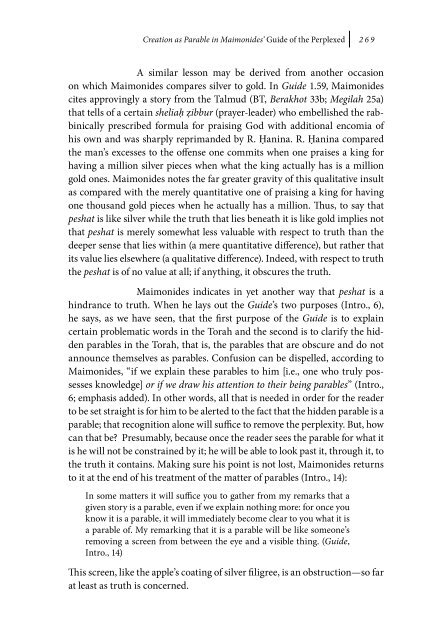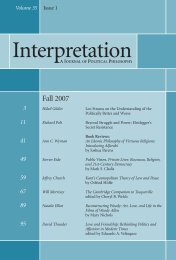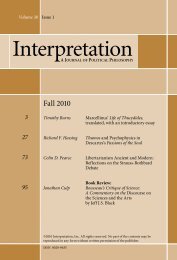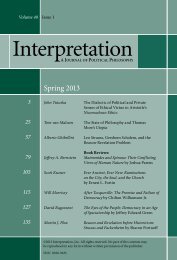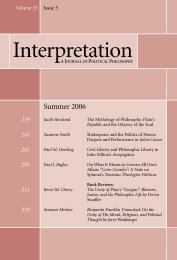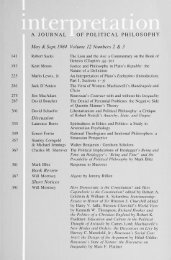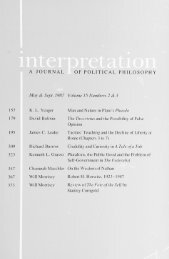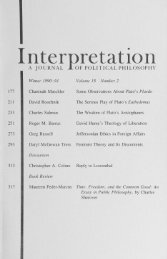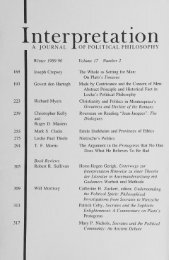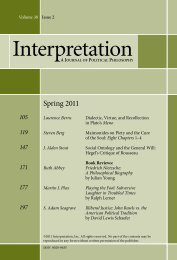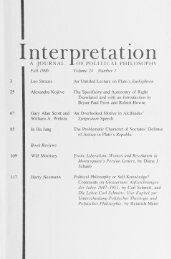Spring 2010 - Interpretation
Spring 2010 - Interpretation
Spring 2010 - Interpretation
Create successful ePaper yourself
Turn your PDF publications into a flip-book with our unique Google optimized e-Paper software.
Creation as Parable in Maimonides’ Guide of the Perplexed<br />
2 6 9<br />
A similar lesson may be derived from another occasion<br />
on which Maimonides compares silver to gold. In Guide 1.59, Maimonides<br />
cites approvingly a story from the Talmud (BT, Berakhot 33b; Megilah 25a)<br />
that tells of a certain sheliaḥ ẓibbur (prayer-leader) who embellished the rabbinically<br />
prescribed formula for praising God with additional encomia of<br />
his own and was sharply reprimanded by R. Ḥanina. R. Ḥanina compared<br />
the man’s excesses to the offense one commits when one praises a king for<br />
having a million silver pieces when what the king actually has is a million<br />
gold ones. Maimonides notes the far greater gravity of this qualitative insult<br />
as compared with the merely quantitative one of praising a king for having<br />
one thousand gold pieces when he actually has a million. Thus, to say that<br />
peshat is like silver while the truth that lies beneath it is like gold implies not<br />
that peshat is merely somewhat less valuable with respect to truth than the<br />
deeper sense that lies within (a mere quantitative difference), but rather that<br />
its value lies elsewhere (a qualitative difference). Indeed, with respect to truth<br />
the peshat is of no value at all; if anything, it obscures the truth.<br />
Maimonides indicates in yet another way that peshat is a<br />
hindrance to truth. When he lays out the Guide’s two purposes (Intro., 6),<br />
he says, as we have seen, that the first purpose of the Guide is to explain<br />
certain problematic words in the Torah and the second is to clarify the hidden<br />
parables in the Torah, that is, the parables that are obscure and do not<br />
announce themselves as parables. Confusion can be dispelled, according to<br />
Maimonides, “if we explain these parables to him [i.e., one who truly possesses<br />
knowledge] or if we draw his attention to their being parables” (Intro.,<br />
6; emphasis added). In other words, all that is needed in order for the reader<br />
to be set straight is for him to be alerted to the fact that the hidden parable is a<br />
parable; that recognition alone will suffice to remove the perplexity. But, how<br />
can that be? Presumably, because once the reader sees the parable for what it<br />
is he will not be constrained by it; he will be able to look past it, through it, to<br />
the truth it contains. Making sure his point is not lost, Maimonides returns<br />
to it at the end of his treatment of the matter of parables (Intro., 14):<br />
In some matters it will suffice you to gather from my remarks that a<br />
given story is a parable, even if we explain nothing more: for once you<br />
know it is a parable, it will immediately become clear to you what it is<br />
a parable of. My remarking that it is a parable will be like someone’s<br />
removing a screen from between the eye and a visible thing. (Guide,<br />
Intro., 14)<br />
This screen, like the apple’s coating of silver filigree, is an obstruction—so far<br />
at least as truth is concerned.


